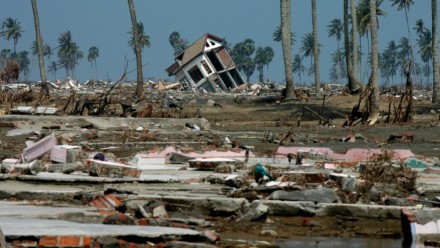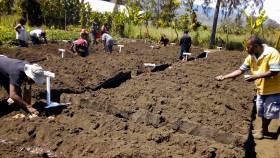ANU research could add life-saving seconds to early warnings for earthquakes and tsunamis
An interdisciplinary team of ANU researchers has identified a sensor that can detect earthquakes and tsunamis seconds or minutes earlier than current disaster early warning systems.
Preliminary modelling suggests that gravitational forces from seismic pressure waves due to earthquakes can be measured by high-precision gravitational force sensors. These measurements can alert seismologists to changes in the gravity field before tremors from earthquakes are registered by the seismometer networks currently used for early warnings.
The seismic pressure waves create changes in the density of the Earth’s crust, resulting in a change of a gravitational force, which in turn are measured by the sensor. “Measuring these tiny forces is extremely challenging, considering they are created by enormous forces and pressure within the earthquake,” says Dr. Bram Slagmolen, Research Fellow at the ANU Centre for Gravitational Astrophysics.
Dr Slagmolen believes that if the feasibility of the sensor being implemented in current operational earthquake systems can be tested, the technology could have significant benefits
“We’ve identified a novel technique for the sensor in the lab. If we can take our testing out of the lab and model the feasibility in real life, the use of gravitational waves detection technology promises to radically shorten lead times of warning systems,” he said.
The transformational technology has the potential to improve the response time to catastrophic events like earthquakes by tens of seconds and tsunamis by tens of minutes, saving many lives and greatly reducing economic loss.
“Having that extra time could give people a chance to move to safer places, critical operations like surgery can be suspended, high speed trains halted, and electrical power stations and gas mains protected,” said collaborator Professor Phil Cummins from the Research School of Earth Sciences, whose research includes earthquakes and tsunami early warning systems.
Dr Roslyn Prinsley, Head of Disaster Solutions at the ANU Institute for Climate, Energy and Disaster Solutions (ICEDS), welcomes the developments in early warning detection. She says that , innovations such as the novel sensors are crucial to disaster preparedness.
“We cannot intervene in earthquakes, so our only options are to build more resilient infrastructure, and to provide more timely warnings to give people sufficient time to move out of harm’s way.” said Dr Prinsley.
“This project could enable Australia to be at the forefront of sensing technology for earthquake and tsunami detection, with potential financial benefit through further deployment of the sensors in the Asia-Pacific region,” she concluded.
“This project could enable Australia to be at the forefront of sensing technology for earthquake and tsunami detection, with potential financial benefit through further deployment of the sensors in the Asia-Pacific region,” she concluded.











